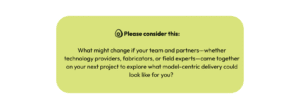Shifting Paradigms:
Enabling Model-Centric Construction Delivery

Contributors: Nick Caravella, Avicado; Jared Christman, Big State Electric; Casey England, Page; Shane Ewing, Martin Martin; Amanda Harbison, ELECTRI; Travis Hawver, University of Texas Austin; Ralph Kreider, Building Better; Nicholas Tilford, Procore; Josh Ward, JHL Constructors; Matt Watts, Avicado
Abstract
The Architecture, Engineering, and Construction (AEC) industry continues to grapple with outdated delivery frameworks that restrict collaborative potential. Despite advancements such as Integrated Project Delivery (IPD) and Lean methodologies, the prevailing design-bid-build paradigm still dominates, limiting early involvement from contractors and trade professionals in critical project decisions. Persistent barriers, including rigid contracts and regulatory mandates, perpetuate reliance on traditional documentation over innovative, model-based solutions. This white paper, based on discussions from one of the AEC Integration Summit (AECIS) Working Groups, argues for a model-centric delivery approach that integrates trade expertise early, empowers collaborative authorship, and enhances project outcomes through digital twins, reduced rework, and optimized project management.
At the heart of this shift is the people—the builders, designers, engineers, and operators who want to do the right thing. We have nothing short of faith in the professionals across our industry to create, collaborate, and take ownership of the value they bring when empowered with the right tools and trust.
<Don’t have time to read it now? Get the PDF sent directly to your inbox>
Current Challenges
Despite technology adoption, project documentation has increased, compounding complexity and diminishing the opportunity for trades to influence design and methodology early in the project lifecycle. The consequence is an over-reliance on extensive documentation, redundant tasks, and reactive processes—ultimately leading to increased RFIs, change orders, disputes, schedule delays, and budget overruns. Notably:
- Up to 52% of construction rework is attributed to miscommunications and bad data.
- Construction professionals currently spend approximately 5.5 hours per week searching for project data and an additional 3.9 hours a week addressing mistakes and rework.
- Rework, often driven by poor coordination and inaccurate project information, accounts for between 4% to 6% of total project costs.
- Only 8.5% of construction projects are completed on time and within budget.
- According to research from the Royal Institution of Chartered Surveyors (RICS), 64% of the industry sees value for digital twins across all building life cycle stages, however, usage is often blocked by the perceived cost, lack of Owner demand, and perceived complexity.
These statistics underscore the critical need for a transformative approach.
Typical Team Involvement and Collaboration Gaps
The following image illustrates typical team involvement in various phases of construction projects, highlighting the imbalance in collaboration and early decision-making:

<Download the PDF of this chart>
The current process results in gaps that are often filled reactively through RFIs, change orders, and significant documentation burdens, further contributing to project delays, cost overruns, and adversarial relationships between teams.
Redefining Project Delivery through Collaboration
The traditional process often results in redundant work and waste—such as duplicating many pages of casework in both design and again in shop drawings; or dimensioning a plan twice, once in design and again in fabrication. These repetitive steps represent missed opportunities to leverage the model as a unified and efficient medium.
By emphasizing collaborative model building as the new deliverable, we unlock significant efficiencies and better align with lean manufacturing principles. Instead of treating model coordination as a separate or redundant step, each stakeholder contributes directly to a shared model from the outset, reducing rework and streamlining decision-making.
The following chart illustrates how team roles and responsibilities evolve under the proposed model-centric approach, emphasizing collaborative engagement and iterative model development:

<Download the PDF of this chart>
By redefining project delivery, this approach realigns team efforts, enhances communication, and minimizes project uncertainties.
Key phases are detailed below, aligning with the collaborative model presented in the chart:
1. Program and Planning
- Early collaborative engagement of design and construction teams in planning phases.
- Enhanced upfront cost control and strategy optimization.
2. Conceptual / Schematic Modeling
- Establish clear delineation between design and construction model responsibilities and engage with them for consulting services.
- Emphasize early and efficient modeling contributions by key trades with focus on construction partners providing expertise on pricing and bidding efforts.
3. Design Modeling
- Minimal viable drawing sets highlighting key spatial, aesthetic, and functional intentions.
- Construction teams provide substantial input on feasible approaches, enhancing clarity and reducing future conflicts.
- Construction Specialties providing services, separate from traditional construction services.
4. Construction Modeling
- Transition of model responsibility to construction teams for detailed development.
- Real-time collaboration between design and construction trade teams, streamlining coordination and facilitating continuous review against design intent.
5. Materials Procurement
- Model-based procurement strategies facilitate strategic sourcing and cost-effective value engineering.
- Optimized trade-offs aligned with overall project financial and operational goals.
6. Execution
- Implementing construction, guided directly by a comprehensive digital twin.
- Continuous updates from the field maintain model accuracy, enabling real-time impacts on scheduling forecasts.
- Streamlined project management, minimal field conflicts and accurate transition to operational stages.
- The closeout phase becomes faster and more complete, as a fully coordinated model already contains asset data, warranty references, and as-built conditions—supporting a more seamless handoff to operations and facilities teams.
This structured yet fluid model-centric approach optimizes each team’s expertise at every phase, significantly enhancing project outcomes.
What-Ifs: Exploring the Impact of a Model-Centric Shift
Before this vision can become reality, it helps to ask some powerful questions. These “what-ifs” are designed to stretch the industry’s imagination—challenging long-standing norms and exploring the untapped potential of a truly model-centric approach:
- What if the boundaries between design and construction were restructured altogether—favoring design-build contractors who integrate engineering and fabrication from the outset?
- The Federal Highway Administration’s Design-Build Effectiveness Study found that projects using design-build reduced durations by 14% and cut total project costs by approximately 3%, all while maintaining quality compared to traditional methods.
- What if delegated design became the norm, allowing those closest to the means and methods to own their scope in the model from day one—improving accountability, reducing handoffs, and fostering buildable design from the start?
- AIA Contract Documents support that delegated design, when contractually supported and clearly defined, enables specialty contractors to contribute earlier and more effectively to the design process. This approach reduces rework, enhances constructability, and accelerates delivery by aligning design intent with real-world construction expertise from day one.
- What if architects could reinvest the time saved from excessive documentation in exploring deeper design thinking or collaborating with engineers, fabricators and end users to create more sustainable, adaptable environments?
- Case studies featured in Architect Magazine show that design-assist collaboration between architects and manufacturers enabled more informed decisions around material systems, constructability, and performance—demonstrating how early and deep collaboration fosters more sustainable and buildable design outcomes when documentation is streamlined and redirected toward integrated problem-solving.
- What if owners could separate management services (including design costs), material costs, and installation costs—gaining greater clarity into value creation and controlling procurement strategy with confidence?
- A McKinsey & Company report highlights that strategic separation of procurement elements enables owners to better align purchasing with project goals—allowing them to leverage buying power, prioritize sustainable materials and mitigate supply chain disruptions, all while improving overall cost predictability and control.
- What if model authorship was transparent, shared, and contractually supported—where the evolution of the model became a managed, auditable process, reducing RFIs and enabling continuous improvement?
- Research published in Buildings (MDPI) supports this vision, showing that use of a Common Data Environment (CDE) with clearly defined authorship, version control, and contractual frameworks fosters collaborative model development, reduces RFIs and enables data-driven continuous improvement.
- What if the digital twin wasn’t something retroactively assembled at the end of a project, but the natural outcome of a collaborative modeling process that spans design, construction, and operations from day one?
- A recent study published in Data in Brief highlights that early integration of digital twins during design and construction fosters better data interoperability, reduces information loss across project phases, and supports continuous lifecycle optimization.
- What if the shift to collaborative modeling enabled a leaner, AI-augmented design process that reduces redundant work and elevates high-value thinking across the entire project team?
- According to Autodesk’s research on AI in architecture, AI tools are enabling firms to automate repetitive, time consuming tasks like documentation, freeing up designers to focus on higher-value work such as creative problem-solving, sustainability and stakeholder engagement.
These provocations drive our vision: a construction industry that doesn’t just digitize old habits, but reimagines its workflows around a shared source of truth—the model.
Conclusion
This shift is not just about adopting new technology—it’s about fundamentally rethinking how we design, build and procure. The industry continues to waste time and money on duplicated documentation, rework caused by ambiguous drawings or delayed decisions, and missed opportunities due to the late involvement of builders. A model-centric approach begins to address these inefficiencies, but the real transformation lies in how responsibilities are distributed and how value is delivered.
By empowering those closest to the means-and-methods to co-author the model, we move beyond static deliverables and toward coordinated action. This shift requires more than tools—it calls for new contracts, new behaviors and a new mindset that rewards early engagement and shared outcomes.
Procurement must evolve too. Rather than bundling services and materials under a single GC umbrella, owners can decouple and evaluate each based on value, transparency and strategic trade-offs. The result? A project that reflects the best thinking of its contributors and a digital twin that evolves naturally throughout the process.
As AI reduces routine A/E production—potentially by as much as 30% according to a session at ENR FutureTech—we have the opportunity to reinvest that capacity into deeper design thinking, closer collaboration and smarter delivery.
Download a PDF of the White Paper
Just leave your email below and keep an eye on your inbox.





